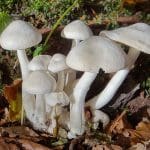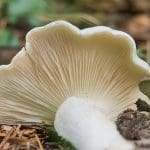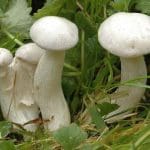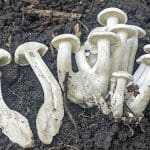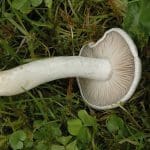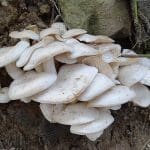White Domecap / Summer / Autumn / Toxic
The White Domecap (Leucocybe connata) is an intriguing and distinctive mushroom that captivates fungi enthusiasts and foragers with its pristine, white appearance and unique growth habits.
Found in clusters on decaying wood and leaf litter in deciduous and mixed forests across Europe and North America, this mushroom is notable for its smooth, domed cap that can reach up to 10 cm in diameter.
The White Domecap’s gills are crowded and white, while its stem is sturdy and also white, sometimes with a slight tinge of cream. One of its distinguishing features is the strong, somewhat unpleasant odour it emits.
In this blog post, we will delve into the key characteristics of the White Domecap, provide tips on accurately identifying it in the wild, and discuss its ecological role.
Scientific Name
Leucocybe connata
Common Names
White Domecap
Family
Lyophyllaceae
Habitat
They are saprobic and normally appear on disturbed soil rich in leaf litter.
Description
They are quite large for russula, getting up to around 20 cm across. Unlike most wild fungi, these blackened caps don’t just turn to mush and rot back into the ground. They dry up and look almost mummified, and you can find their black remnants lying around for months.
Identifying Features of the White Domecap:
Cap:
The cap is almost pure white and convex when young, They open out to become almost flat, sometimes developing a wavy edge and they usually retain an enrolled rim.They become more dirty white/brown with age.
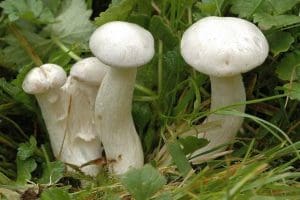
Stem:
The stem is white, firm, and usually bent where it joins the base. Measuring between 5–8 cm long, they tend to become hollow with age.
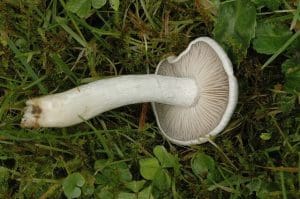
Gills:
When young the gills are white, crowded and adnate to slightly decurrent.
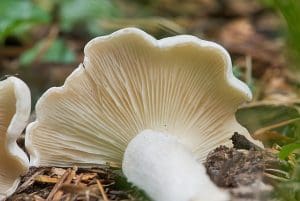
Smell:
No distinct smell.
Spores:
White.
Uses of White Domecap (Leucocybe connata)
In food
Opinions vary greatly. The species was considered a good edible until quite recently when it was discovered to contain a chemical with the ability to generate mutations in DNA. Another compound was also discovered that had a carcinogenic effect on animals. Then a few years ago, a mycological toxicology conference was held, during which the species was practically removed from the category of toxic species and considered edible again.
Known hazards
I would advise eating them in moderation or avoiding them completely.
Potential lookalikes of the White Domecap (Leucocybe connata)
The White Domecap (Leucocybe connata) can be easily confused with several other white mushrooms, especially by those new to mushroom foraging. Here are some common look-alikes and the key differences to help in accurate identification:
- Clitocybe Dealbata (Ivory Funnel)
- Appearance: Also white and similar in size, with a funnel-shaped cap and decurrent gills.
- Key Differences: The Ivory Funnel has a more pronounced funnel shape as it ages and has a strong, unpleasant smell. It is also toxic, causing gastrointestinal distress, unlike the White Domecap, which lacks such toxicity.
- Clitocybe Rivulosa (Fool’s Funnel)
- Appearance: Similar white colour and size, often found in grassy areas.
- Key Differences: The Fool’s Funnel also has decurrent gills and can develop a slightly wavy cap margin. It is highly toxic, containing muscarine, whereas the White Domecap does not.
- Tricholoma album (White Knight)
- Appearance: White with a domed cap, similar to the White Domecap.
- Key Differences: The White Knight has a bitter taste and a mealy smell, whereas the White Domecap has a somewhat unpleasant but different odour and a smoother cap texture.
- The Domecap is not mycorrhizal and so they can grow well away from trees.
- Also White Domecaps generally grow in fused tufts, while the Tricholoma’s appear singly or in trooping groups.
- Lepista Irina (Flowery Blewit)
- Appearance: White to pale cream, with a smooth, convex cap.
- Key Differences: The Flowery Blewit has a distinct floral scent and slightly pinkish gills, especially in older specimens, unlike the pure white gills of the White Domecap.
- Leucopaxillus Giganteus (Giant Funnel)
- Appearance: Larger size, with a white to cream colour.
- Key Differences: The Giant Funnel can grow much larger, with caps up to 50 cm in diameter, and has a more pronounced funnel shape. The White Domecap is smaller, with a domed cap that does not develop a funnel shape.
- The Destroying Angel (Amanita virosa)
It’s almost pure white, but this has a ring on the stem and grows from a volva, this is an incredibly dangerous mushroom.
Extra Notes
The ‘connatum’ part of the scientific name comes from Latin and means ‘born together’, in reference to the way they fruit in tufted groups rather than singly.
References:
https://www.first-nature.com/fungi/lyophyllum-connatum.php



